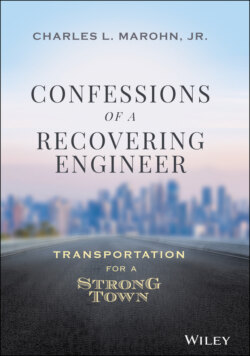Читать книгу Confessions of a Recovering Engineer - Charles L. Marohn Jr. - Страница 8
The Crossing
ОглавлениеWhat happened that night on State Street seems obvious. In a karmic world where we all, to one degree or another, must live with the consequences of our decisions, it's easy to see how Gonzalez made a series of bad choices.
She could have walked to the traffic signal, but she didn't. Traveling four feet per second with two kids in tow, it would have taken her roughly one minute and ten seconds to get there. Depending on her luck, she might not have had to wait at all to cross if the light happened to be green in her direction. If it was red, she might have been there another minute, perhaps longer. It would have taken an additional minute and ten seconds to walk back along the opposite sidewalk. To walk to the signal instead of crossing directly meant it would take an additional two to four minutes to get to her car.
Two to four minutes. That is what was saved by crossing directly in the middle of the block instead of walking to the signal — one dead, one seriously injured, and lives forever damaged. It seems like an extraordinarily high price to pay for what could casually be described as impatience.
That's not to suggest that crossing the street mid-block was effortless. To cross in front of the library, Gonzalez had to walk around a row of shrubs. To reach the street, she also needed to step over a small fence, nothing more than a couple of decorative chains hanging between posts. These obstacles were put there to discourage people from crossing in this location, a fact that is self-evident to anyone who chooses that route.
We can think of these obstacles as a warning: DO NOT CROSS HERE. Gonzalez did not heed this clear warning.
From curb to curb, State Street is 40 feet wide in this location. At a normal walking speed, the three of them would be exposed to traffic for at least 12 seconds, assuming that they could proceed in one smooth crossing.
That is 12 seconds in an area where Gonzalez knew that a traffic signal would not be stopping oncoming traffic. She also had to have known that at least some of these drivers might not anticipate people crossing mid-block, especially at that hour. Those drivers would not be alert for the possibility that she and the girls would be there.
Of the four lanes on State Street, two convey traffic to the north and two to the south. Crossing safely here requires one to time a gap within the multidirectional traffic flow, a task made more difficult at night. What often happens in these situations is that the person crossing can anticipate the gap only in the two nearest lanes. They venture out and often find themselves trapped in a traffic lane, fully exposed, waiting for the furthest two lanes to provide the gap that they need to finish the crossing.
Sagrario Gonzalez had done this crossing many times. She knew all of this. Everyone in Springfield knows this, and most of us, if we visited the site and looked at it, would intuitively understand it as well.
What Gonzalez did was very dangerous. She did it despite the clear warnings. She did it to save a couple minutes of time. She did it despite having two small children in her care, young people who would face the risk with her and pay a heavy price.
This was Gonzalez's choice. It is easy to say this was Gonzalez's fault.
Too easy. It wasn't her fault.
